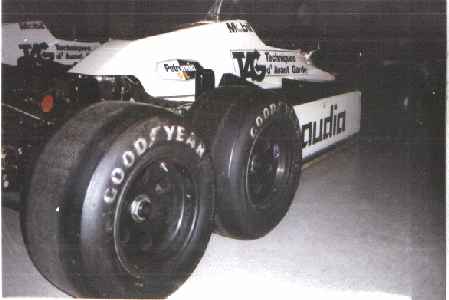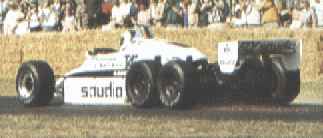Over the years, in an effort to remain ahead of the competition, there have been a number of technical advances which have stretched the rules to the very limit, such as Brabhams ‘Fan Car’. Many have never made it off the drawing board, others have, only to be banned, after contesting only one race in the case of the fan car.
Over the history of Formula One a recurring theme is that of the six-wheeler, now specifically banned, but at one time March, Tyrrell and Williams all had six wheeled cars in various stages of development. All had the same objective – more grip. Of the three the Tyrrell P34 was the most successful and remains the only six-wheeled car to have won a race, Sweden in 1976, when Patrick Depailler followed home Jody Scheckter.
Williams had two attempts at a six-wheeled car – the FW07C and a year later the FW08D.

After carrying out some detailed calculations, Patrick Head reached the conclusion that the very large contemporary rear tyres used by F1 cars were responsible for something in the order of 40 per cent of the machine’s overall aerodynamic drag. His wind tunnel investigations had suggested that a six-wheeler, using four small rear wheels to do the driving, would offer a significant performance improvement.
The rival March team had made a prototype of a similar system back in 1977, but lacked the necessary funds to develop the concept. Head, however, pressed on with his interpretation of the theme.
Hewland, the Maidenhead, UK, based specialist gear manufacturers, offered some assistance with the package, drawing on the experience gained with March.
The new rear end set-up was centred on the conventional two-wheeled drive car’s rear axle centre line, so the leading rearward axle of the six-wheeler was placed four inches ahead of the regular position and the drivershafts angled to cope. The rearward axle was driven be an additional final drive unit added on to the back of the transmission package.
The prototype Williams FW07D six-wheeler was sampled by Alan Jones at Donnington Park just after his victory in the 1981 Caesars Palace Grand Prix at Las Vegas, his final triumph for the team. He was impressed, but it’s rocket-like acceleration and outstanding grip were not in themselves enough to persuade the tough Aussie to revoke his retirement decision.
The system surfaced again during 1982 when Keke Rosberg tried an FW08, similarly equipped, during testing at Paul Ricard. Patrick had to re-think the concept to overcome the difficulty of packaging the aerodynamic underwings, but the whole project came to nothing when six-wheelers were specifically banned at the start of 1983.

One of the original cars is now held within the Williams Collection and is occasionally taken out. It was raced by Jonathan Palmer at the Goodwood Festival of Speed in 1994, setting the course record against more powerful machinery, showing what a force it could have been.


